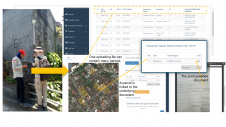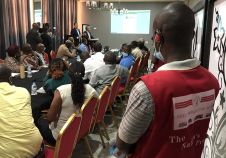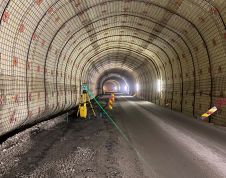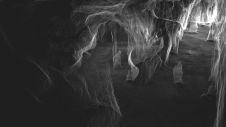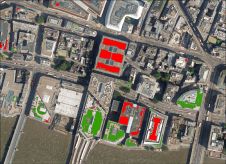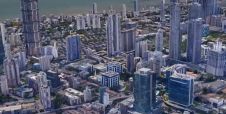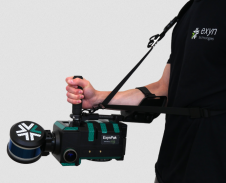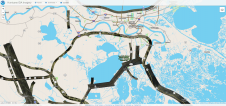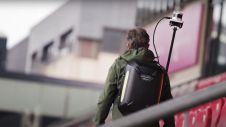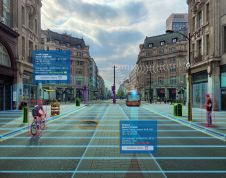Bridging the Gap between Aerial Imaging and Terrestrial Data Capture
The Challenges of Drone Use in Facade Mapping
近年来,无人航空系统取得了迅速的进步,但人们普遍认为,我们仍然只看到无人机(无人机或“无人机”)最终可以提高地理空间专业人员及其客户的效率的一小部分。瞥见未来,”188金宝搏特邀Gim International'spoke to Mark Nicolai, co-founder of industry start-up Aeroscan. Here, he shares his vision of how drones could form the missing link between aerial imaging and terrestrial data capture.
According to independent research by the likes of PwC and Goldman Sachs, the construction industry tops the list in terms of commercial drone use and is by far the fastest growing sector. UAVs are becoming increasingly commonplace on building sites, enabling construction companies to monitor progress with ever-greater accuracy, efficiency and safety. The use of data captured by anunmanned aerial system(UAS) is also on the rise in 3D models for construction planning and design purposes. Drone deployment has reached a sufficient level of maturity that activities such as UAV-based roof inspections have become fairly routine. Now, a Dutch startup called Aeroscan is taking things a step further and exploring the use of drones for facade mapping. “If this can be achieved, it will have major implications – not only for construction and real estate but also for infrastructure, law enforcement, emergency services, local governments and so on. It relates to every business case already using aerial data, plus it will unlock countless new business cases by providing higher-quality data and more detailed information about the local environment,” states Mark Nicolai, one of the two co-founders ofAeroscan.
Founded in mid-2017, Aeroscan is actually the result of three businesses: a leading Dutch construction company, an IT company specialized in the development of cloud software for construction management, and Nicolai’s visual media company which he started in 2008 and which produced promotional videos and photos of building sites for construction companies, including using drones. “Our photos were mainly used for marketing purposes, but technical departments started to ask whether they could use the photos for calculation purposes too,” recalls Nicolai. “So we increasingly moved into drone-based imaging for construction firms and social housing associations. We have the necessary equipment, certificates and a dedicated drone crew to collect data. We also have customers who are already using our software and 3D models to obtain objective data as the basis for reports, calculations, estimates for repair, and so on. But we’ve noticed that large property owners have a need for real-world insights into the condition of their properties, including their facades, so we decided to take a risk and investigate whether UAVs could be used for this.”

Helping to shape EU drone regulations
“与另外两个合作伙伴一起,VMRG和奥克托,we received €1.6 million of EU (EFRO) subsidy from the ‘Kansen voor West II’ programme as part of a three-year project called the Facade Service Application (FaSA). The project involves a consortium of dozens of contractors and multinationals from the entire chain of producing, installing and maintaining facades. We needed a drone operating licence for the built environment, so we applied to the Dutch aviation authority (ILT). When the people at ILT heard about the FaSA project, they invited Aeroscan to work within the framework of a Specific Operations-based Risk Assessment (SORA) for drones and to cooperate with them on theJarus项目which is helping to shape the future of EU drone regulations,” he continues. The Joint Authorities for the Rulemaking of Unmanned Systems (JARUS) is a group of experts from the national aviation authorities (NAAs) and regional aviation safety organizations working to recommend a single set of technical, safety and operational requirements for the certification and safe integration of unmanned aircraft systems (UAS) into airspace and at aerodromes. Presently involving 59 countries, as well as the European Aviation Safety Agency (EASA) and EUROCONTROL, the objective of JARUS is to facilitate each authority to write their own requirements. “In the JARUS project the focus is on presenting a real-life scenario and operation-based risk assessment and proving that your business case is safe. So this was a unique opportunity for Aeroscan to work on this conceptual new framework for future EU regulations based on our actual business plan,” explains Nicolai. “After a process of 16 months, we finally gained approval for our developed scenario in late December 2018 and we now have the most complete certificate that’s possible today: we are flying our drones on a kind of ‘temporary exemption’ based on future EU regulations that are still being developed!” he adds. As a result, Aeroscan became the first company in the history of the Dutch UAV industry to receive an official permit for flying drones in urban areas. “We’re gaining valuable knowledge and insights about how to investigate measures and risks in the field, which we share with ILT. By continuing to work with the authorities we hope to help expand the possibilities of flying in urban areas for the industry as a whole.”

Field pilots for housing associations
为客户在房地产行业,Aeroscan”s long-term aim is to offer UAV city mapping in combination with photogrammetry/data processing, and to combine automatic image and object recognition techniques with UAV data to find flaws in real estate such as cracks in facades or window frames that need repainting. The company ultimately hopes to generate maintenance insights and data visualizations based on the analysis. So far, the main focus is on the operational aspect, i.e. data acquisition. “Since gaining the licence, we have conducted several pilot projects for social housing firms and property companies using existing off-the-shelf technology. In fact, our first pilot – mapping a row of terraced houses in a small Dutch city – was the country’s first ever official flight of a UAV over an urban area to inspect residential properties. As it was our first time in the field, we just wanted to explore the drone’s performance when exposed to environmental factors such as Wi-Fi signals, GPS, jamming, blocking, reflections, turbulence and gusting around buildings, for example.” The drone hardware Aeroscan uses is anIntel Falcon8+, which Nicolai considers perfectly suited for inspection flights in high-risk urban environments due to its small size, low weight (just 2.5kg) and eight engines giving triple redundancy (i.e. it can still land safely even if two engines fail). In terms of the imaging sensor, the aircraft is fitted with the high-end Sony A7R full-frame camera to capture images in high resolution. As it turned out, there were no interference problems and the drone data was successfully post-processed into accurate and georeferenced nadir maps of the rooftops.
Simulating a multi-camera rig
In subsequent pilots Aeroscan has increasingly explored how to capture images of facades, because that is where the real added value lies for housing associations. “To tackle the challenge of vertical mapping, we took inspiration from the manned aircraft approach. We started to create flight plans to generate relevant datasets based on the workflow in Bentley’sContextCapture, considering overlap rules, angle shifts between cameras and so on. In our most recent pilot for a social housing association in a densely populated urban area of a major Dutch city, we worked with an acquisition plan to simulate a multi-camera rig you would commonly find on a manned aircraft. So we designed a setup in which the drone passed each point multiple times, with the camera pointing in a different direction and at a different angle each time. Of course there’s only one camera on the drone, so we had to conduct multiple flights, which means it’s not really such an efficient approach right now.”

Overcoming bottlenecks
Aeroscan团队对这种低效率的效率并不局限,并看到了各种改进的方法。“现成的硬件解决方案不是基于无人机的映射场景,因为当前的立法情况意味着对它们没有需求;到目前为止,载人飞机一直是唯一的空中选择。我们确实需要一个多重摄像机的传感器,该传感器足够轻巧,可以通过一个小型无人机携带,但提供了足够的校准以确保固定的重叠和地理标准准确性。但是我认为这不是一个巨大的问题,可以结合和完善某些类型的现有硬件。”尼古拉说。“例如,下一代'甲虫'无人机 - 重量仅10至20公斤,并将垂直起飞能力与固定翼无人机的范围结合在一起 - 例如,可以接近匹配载人飞机的效率。话虽如此,他们在一个小时内的飞行范围约为100公里,这引发了其他问题,例如,需要制定哪种安全标准,以使视觉线(BVLOS)在预定义的网格上允许100公里以外的视觉线(BVLOS)飞行任务。因此,也许在城市地图中的无人机部署将暂时仅限于小区域项目,但即使如此,它仍然可以成为使用载人飞机或陆地地图的有趣替代方法。”
Customer response
在人口稠密和拥挤的城市地区进行低空飞行不仅会引起安全问题,而且引起了隐私问题。尼古拉(Nicolai)解释说,大多数客户对使用无人机技术的合作感到兴奋,因为无人机通常被认为是“酷而有趣”,但是在实用的层面上,住房协会的租户并不总是立即渴望在他们的后院或阳台上飞行无人机。Aeroscan从两个角度解决了这些问题:立法和社会接受。“在法律方面,我们与住房协会的客户紧密合作,以确保与租户的租金协议实际上为他们提供了使用无人机进行检查的法律理由。但是对我们的Aeroscan中,更重要的是社会感知,并确保我们不会侵犯任何人的隐私,因此我们已经开发了自动化的工作流程,以匿名化敏感数据,例如面部或数字板,” Nicolai说。“在飞行员中,我们将优先考虑到所有参与其中的家庭,包括通过小组访谈和信息活动来评估人们的经历。我们尝试让尽可能多的租户参与其中。毕竟,无人机只是另一个工具。实际上,它可能比当前的手动检查方法不那么侵入性,在这种手动检查方法中,检查员实际访问房屋,有时需要在人们的房屋和花园内进行通道。”

Next steps
现在操作方法已经被证实to work in practice, Aeroscan is advancing to the next phase of developing an end-to-end solution: processing. “During the pilot projects, the datasets were modelled in a pipeline created with ContextCapture. We then supplied those models to our clients as raw data. But we are about to launch our own cloud-based platform with enhanced visualization functionalities so that customers can gain access to the deliverables in their preferred data format, such as high-resolution photography, meshes, orthos or whatever,” he continues. “Then the next step will be to develop automated analysis to truly unburden our clients. That’s our aim: to take an industry-specific and customer-specific approach in order to provide the insights that social housing associations need. We’re partnering with OCTO – a specialist in smart asset management and big data analysis – within the FASA project, for example. By the end of this year, we hope to be conducting tailormade drone missions for property companies based on their predefined business cases: the defects or objects they want to count, measure or find automatically within an area. The information our solution provides will enable them to focus on their core business: planning and performing the necessary maintenance of their properties to ultimately make life better for their tenants.”

Although Aeroscan still has some development work to do, the company is clearly on the right track towards developing an industry-specific end-to-end solution that adds real value for its clients in the Dutch social housing sector. If this is a success, there is no reason why it cannot be rolled out internationally and/or used for other smart-city applications. It remains to be seen how quickly the industry will ‘catch up’ in terms of developing the miniaturized hardware that is required to expand the horizons of drone-based city mapping beyond the nadir view. The topic of legislation and flying permits remains a crucial issue, of course, but the Aeroscan team are certainly doing everything they can to ensure the upcoming EU-wide legislation works in practice so that professional users can truly exploit the full potential of drones for city mapping in the near future.
Further Reading
https://www.goldmansachs.com/insights/technology-driving-innovation/drones/
https://www.pwc.pl/pl/pdf/clarity-from-above-pwc.pdf














